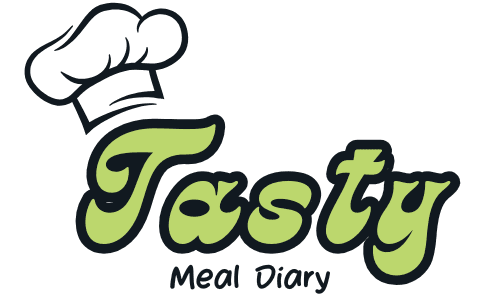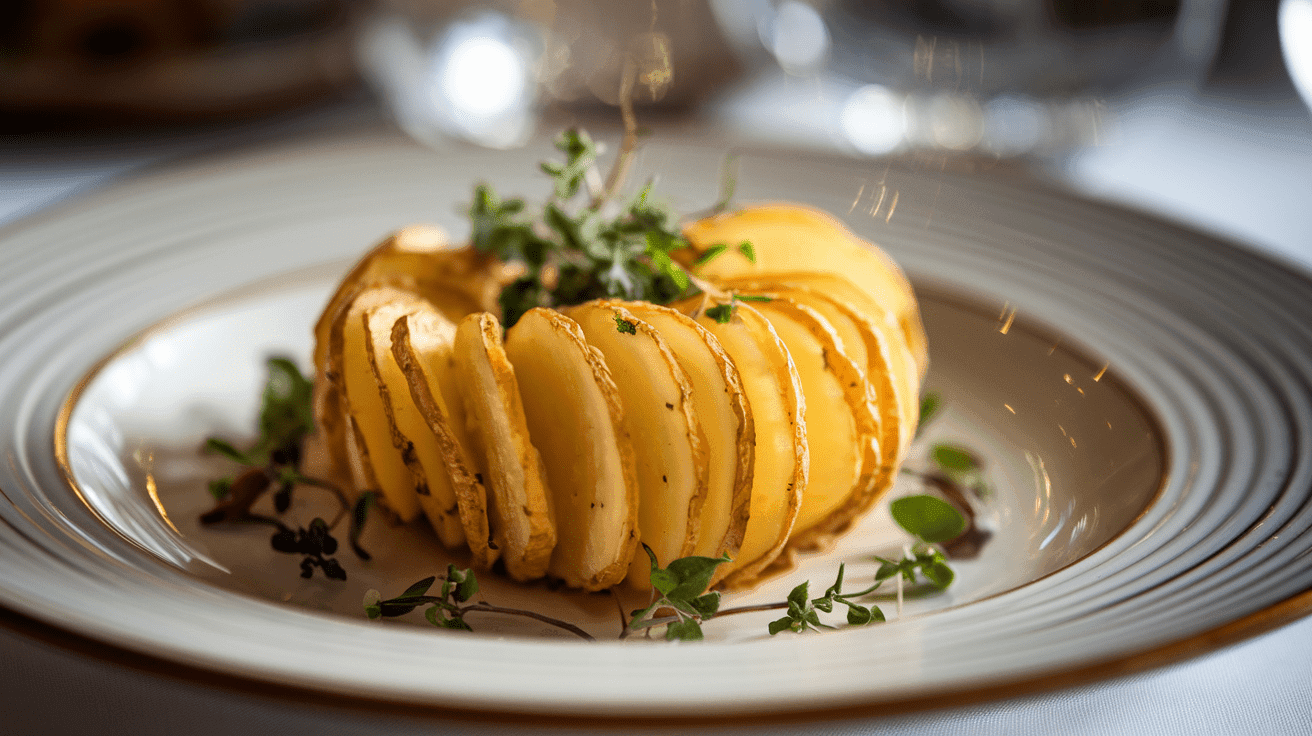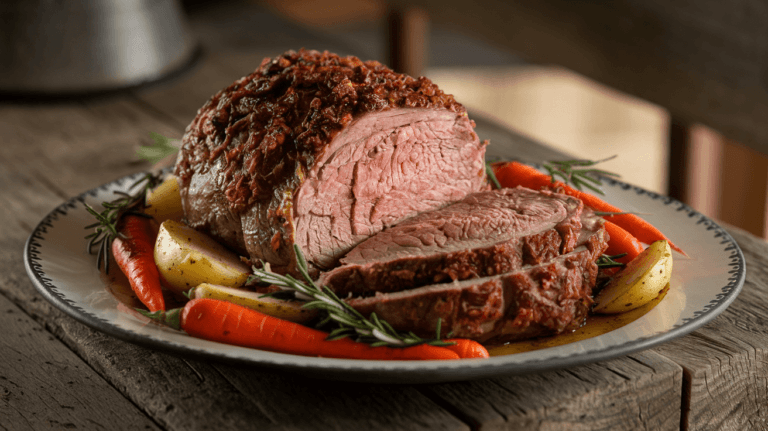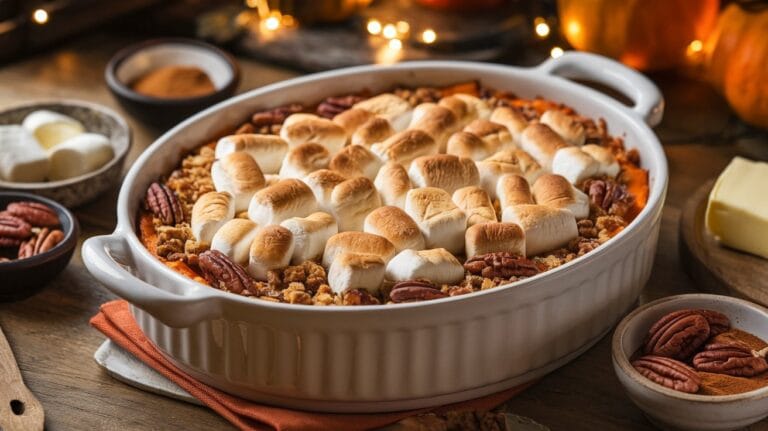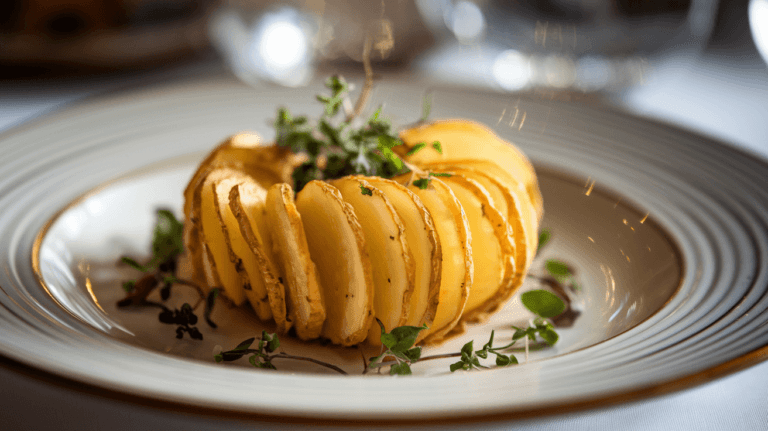If you love crispy, golden layers of thinly sliced potatoes that melt in your mouth, then Potato pave recipe is about to become your new favorite dish. This classic French potato recipe is a masterpiece of texture and flavor, combining the creamy richness of potato gratin with the structured elegance of a terrine.
In this guide, we’ll take you through everything you need to know about potato pavé, from its origins to step-by-step instructions, expert tips, variations, and serving suggestions. Whether you’re preparing it for a fine-dining experience or simply want to impress your guests at home, this article will ensure you get the perfect crispy potato pave every time.
Table of Contents
What is Potato Pave?
Origins of Potato Pavé
The term pavé comes from the French word for “paving stone,” referring to the neatly layered, compact shape of this dish. Traditionally, potato pavé consists of thinly sliced potatoes stacked, baked with cream and butter, then pressed overnight to create a dense, uniform block. Once set, it’s cut into perfect squares and crisped to golden perfection in a pan or oven.
While potato pavé is often associated with modern haute cuisine, its roots trace back to classic French cooking techniques, similar to dishes like potato gratin and dauphinoise potatoes. Culinary legends such as Thomas Keller have popularized this dish in fine-dining restaurants, but with the right techniques, it’s entirely achievable at home.
The Meaning of “Pavé” in French Cuisine
In French culinary terms, “pavé” refers to any food prepared in a rectangular or square shape. You’ll often see it used for fish, steak, or even chocolate desserts. When applied to potatoes, it describes the precise layering and compact form that give the dish its signature appearance.
Why This Dish is a Favorite Among Chefs
So, what makes potato pavé stand out from other potato dishes? It’s all about texture. Unlike mashed potatoes or scalloped potatoes, pavé delivers:
- Crispiness – Thanks to its final sear in a pan or oven.
- Creaminess – The layers soak up butter and cream, creating a velvety interior.
- Aesthetic Appeal – Those perfect square layers make it a showstopper on any plate.
Ingredients for the Perfect Potato Pavé
Choosing the Right Potatoes: Russet vs. Yukon Gold
The secret to a flawless potato pavé starts with the right potatoes. High-starch varieties like Russet and Idaho potatoes are ideal because they hold their shape while delivering a soft, creamy texture. These varieties absorb butter and cream beautifully, ensuring that each bite is rich and smooth.
If you prefer a silkier texture, Yukon Gold potatoes are a great alternative. They have a naturally buttery flavor and a slightly firmer consistency. However, because they contain less starch, they may not crisp up as much when fried.
Dairy Choices: Heavy Cream, Butter, or Alternatives
To achieve the signature creamy layers, most recipes call for heavy cream and unsalted butter. The cream binds the potato slices together while keeping them moist, while butter adds richness and enhances the crispiness when seared.
For a lighter alternative, you can substitute:
- Half-and-half instead of heavy cream.
- Olive oil or ghee in place of butter.
- Coconut cream or cashew milk for a dairy-free option.
Seasonings and Flavor Enhancements
A basic potato pavé relies on salt, black pepper, and a hint of garlic, but there’s plenty of room for creativity. Popular add-ins include:
- Fresh herbs like thyme, rosemary, or chives.
- Cheese such as Parmesan, Gruyère, or aged cheddar for extra depth.
- Truffle oil or infused butter for a gourmet touch.
- Paprika or nutmeg to enhance the savory-sweet balance.
Step-by-Step Guide to Making Classic Potato Pavé
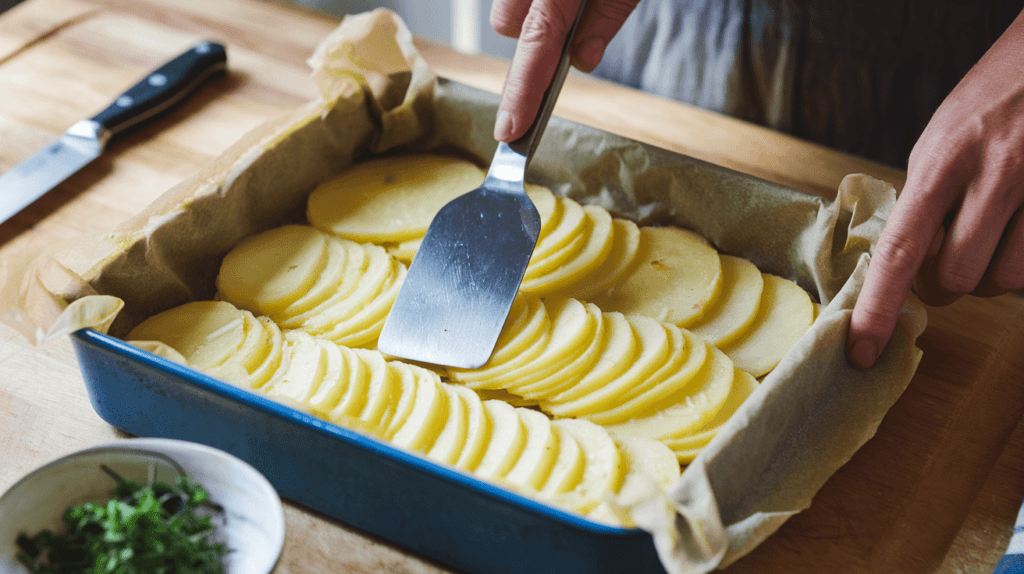
Step 1: Preparing the Potatoes – Peeling, Slicing, and Soaking
Start by peeling the potatoes and cutting them into uniform slices about 1-2 mm thick. Using a mandoline slicer ensures even slices, which is key for maintaining a consistent texture.
To prevent oxidation and remove excess starch, soak the slices in cold water for 10-15 minutes. Drain and pat them dry with a paper towel before assembling.
Step 2: Layering and Seasoning for Optimal Texture
Preheat your oven to 325°F (163°C) and prepare a parchment-lined baking dish. Begin layering the potato slices, slightly overlapping each one. Every few layers, brush with melted butter and heavy cream, then season with salt, pepper, and your choice of herbs or cheese.
Step 3: Baking and Pressing – The Secret to the Perfect Consistency
Cover the dish with foil and bake for 90 minutes until the potatoes are tender. After baking, remove from the oven and place a heavy pan or weighted dish on top to compress the layers.
Refrigerate for at least 8 hours or overnight. This crucial step helps the layers set, making slicing easier and ensuring a firm structure.
Step 4: Slicing and Crisping for a Golden Finish
Once chilled, carefully lift the potato block from the dish and slice it into even squares or rectangles.
To achieve the signature crispy exterior, heat a nonstick pan with a small amount of oil or butter over medium-high heat. Sear each piece for 2-3 minutes per side, until golden brown and crispy.
At this point, your potato pavé is ready to serve! It pairs beautifully with steak, roasted chicken, or seafood, making it a versatile side dish.
Variations of Potato Pavé
Thomas Keller’s Famous Potato Pavé
One of the most well-known versions of potato pavé comes from Chef Thomas Keller, who introduced a refined, restaurant-quality take on this dish. His version is all about precision and technique, requiring ultra-thin potato slices and a slow-baking process that results in an incredibly delicate texture.
- Use Russet potatoes for structure and a creamy texture.
- Layer with clarified butter instead of heavy cream for a richer taste.
- Press overnight and fry in duck fat for an ultra-crispy, golden crust.
Cheesy Potato Pavé with Gruyère and Parmesan
If you’re a fan of cheesy potato dishes, this variation is for you! Adding cheese between the layers creates an extra gooey, indulgent version of potato pavé. The best cheeses to use are:
- Gruyère – Melts beautifully and adds a slightly nutty flavor.
- Parmesan – Sharp and salty, perfect for extra depth.
- Cheddar – A bolder choice for those who love strong cheese flavors.
Simply sprinkle cheese between layers before baking, and consider finishing with a Parmesan crust for a crisp, cheesy topping.
Vegan Potato Pavé with Dairy-Free Alternatives
- Olive oil or vegan butter for richness.
- Coconut cream or cashew milk for a creamy texture.
- Nutritional yeast for a cheesy, umami flavor.
Spiced Potato Pavé with Herbs and Garlic
- Smoked paprika for a deep, smoky taste.
- Roasted garlic mashed into the cream or butter.
- Fresh rosemary or thyme for an herby aroma.
For more delicious potato-based recipes, check out our Cheesy Potatoes Recipe Guide.
Pro Tips for Achieving the Perfect Potato Pavé
The Importance of a Mandoline for Consistent Slices
To get that signature layered look, even slices are crucial. Using a mandoline slicer ensures paper-thin, uniform cuts, which help the layers cook evenly and hold together after baking. If you don’t have a mandoline, use a sharp chef’s knife, but take your time for precision.
How to Press the Potatoes for Maximum Firmness
Pressing is the game-changer in potato pavé. Without this step, the layers can fall apart when slicing. After baking:
- Place a weighted pan on top of the cooked potatoes while still warm.
- Refrigerate overnight – This step is essential for setting the structure.
- Use a sharp knife to cut clean, even squares before crisping them.
Best Cooking Techniques: Oven vs. Air Fryer vs. Pan Frying
You can crisp potato pavé in different ways:
- Pan-frying – The classic method for a golden-brown crust and rich, buttery flavor.
- Air frying – A lower-fat alternative that still delivers crispy edges.
- Oven-baking – Works well if you’re making a large batch, but may take longer to crisp.
Serving Suggestions and Pairings

What to Serve with Potato Pavé
Potato pavé is more than just a side dish it’s a showstopper that pairs well with a variety of main courses. Its rich, creamy interior and crispy exterior complement both meat and vegetarian dishes. Here are some fantastic pairings:
- Steak or Grilled Meat – The crispy layers of potato pavé balance beautifully with a juicy ribeye, filet mignon, or roasted lamb chops.
- Roast Chicken or Duck – A simple herb-roasted chicken or crispy-skinned duck breast pairs perfectly with the buttery potatoes.
- Seafood – Serve potato pavé alongside seared salmon, scallops, or lobster for a gourmet experience.
- Vegetarian Dishes – Try pairing it with a mushroom ragout, roasted Brussels sprouts, or a fresh arugula salad for a balanced meal.
Wine and Beverage Pairings
Choosing the right drink enhances the experience of potato pavé. Consider these options:
- White Wine: A buttery Chardonnay or a crisp Sauvignon Blanc complements the creamy texture.
- Red Wine: A light Pinot Noir or bold Cabernet Sauvignon pairs well with meat-based dishes.
- Cocktails: A classic Old Fashioned or sparkling French 75 adds elegance to the meal.
- Non-Alcoholic: A sparkling lemon water or herbal iced tea keeps things refreshing.
Presentation Tips for a Stunning Plating
For a restaurant-worthy presentation, slice potato pavé into clean squares and stack or fan them out on the plate. Garnish with fresh herbs, a drizzle of truffle oil, or a sprinkle of flaky sea salt for an elegant finish.
FAQs
Can I Make Potato Pavé Ahead of Time?
Yes! Potato pavé actually tastes better when made ahead. Since it needs time to set in the fridge, preparing it a day in advance is ideal. Just slice and crisp it right before serving for the best texture.
How Do I Store and Reheat Potato Pavé?
To store leftovers, place the potato pavé in an airtight container and refrigerate for up to 3 days. To reheat:
- Oven: Bake at 375°F (190°C) for 10-15 minutes.
- Stovetop: Sear in a hot pan with a bit of butter.
- Air Fryer: Crisp at 375°F (190°C) for 5-7 minutes.
Avoid microwaving, as it can make the potatoes soggy instead of crispy.
What Are the Best Potatoes to Use for This Recipe?
For the best results, choose starchy potatoes like Russet or Idaho. They hold their structure well and soak up the creamy ingredients. Yukon Gold is a great alternative for a slightly firmer texture.
Can I Make This Recipe Without Dairy?
Absolutely! To make a dairy-free potato pavé, swap out the butter and cream for olive oil, vegan butter, and coconut or cashew cream. The texture remains creamy, and you can still achieve crispy, golden edges.
Common Mistakes to Avoid When Making Potato Pavé
Even though potato pavé seems straightforward, a few small mistakes can affect the final result. Here are the most common pitfalls and how to avoid them.
Using the Wrong Type of Potatoes
Not all potatoes work well for potato pavé. Avoid waxy potatoes like red potatoes, as they don’t absorb cream and butter well. Instead, go for Russet or Yukon Gold potatoes, which provide the perfect balance of starchiness and creaminess.
Skipping the Soaking Step
After slicing the potatoes, soak them in cold water for 10-15 minutes to remove excess starch. Skipping this step can lead to gluey or sticky layers that don’t hold their structure well.
Not Pressing the Potatoes Properly
One of the biggest mistakes is not pressing the pavé after baking. Without this crucial step, the layers won’t set, and the dish may fall apart when slicing. Always press it with a heavy pan or weight overnight in the fridge.
Rushing the Crisping Process
For a perfectly crisped potato pavé, patience is key. Some people try to sear it over high heat, but this can burn the outside before the inside warms through. Instead, use medium heat and a little butter or oil, allowing the crust to develop gradually.
Final Thoughts and Recipe Recap
Mastering potato pavé takes a little patience, but the results are well worth the effort. With its crispy, golden exterior and melt-in-your-mouth layers, this dish can turn any meal into a fine-dining experience.
To recap, here’s a quick step-by-step summary:
- Choose the right potatoes – Go for Russet or Yukon Gold.
- Slice them evenly – Use a mandoline slicer for best results.
- Layer with butter and cream – Season each layer well.
- Bake, then press overnight – This ensures a firm texture.
- Slice and crisp before serving – Pan-fry in butter or oil for a golden crust.
Whether you’re making a classic version, a cheesy twist, or a vegan alternative, this dish is sure to impress. Serve it with steak, seafood, or roasted vegetables, and pair it with a glass of wine or a refreshing cocktail for a complete gourmet meal.
If you’re looking for more tasty recipes, check out our collection of delicious meal ideas!
